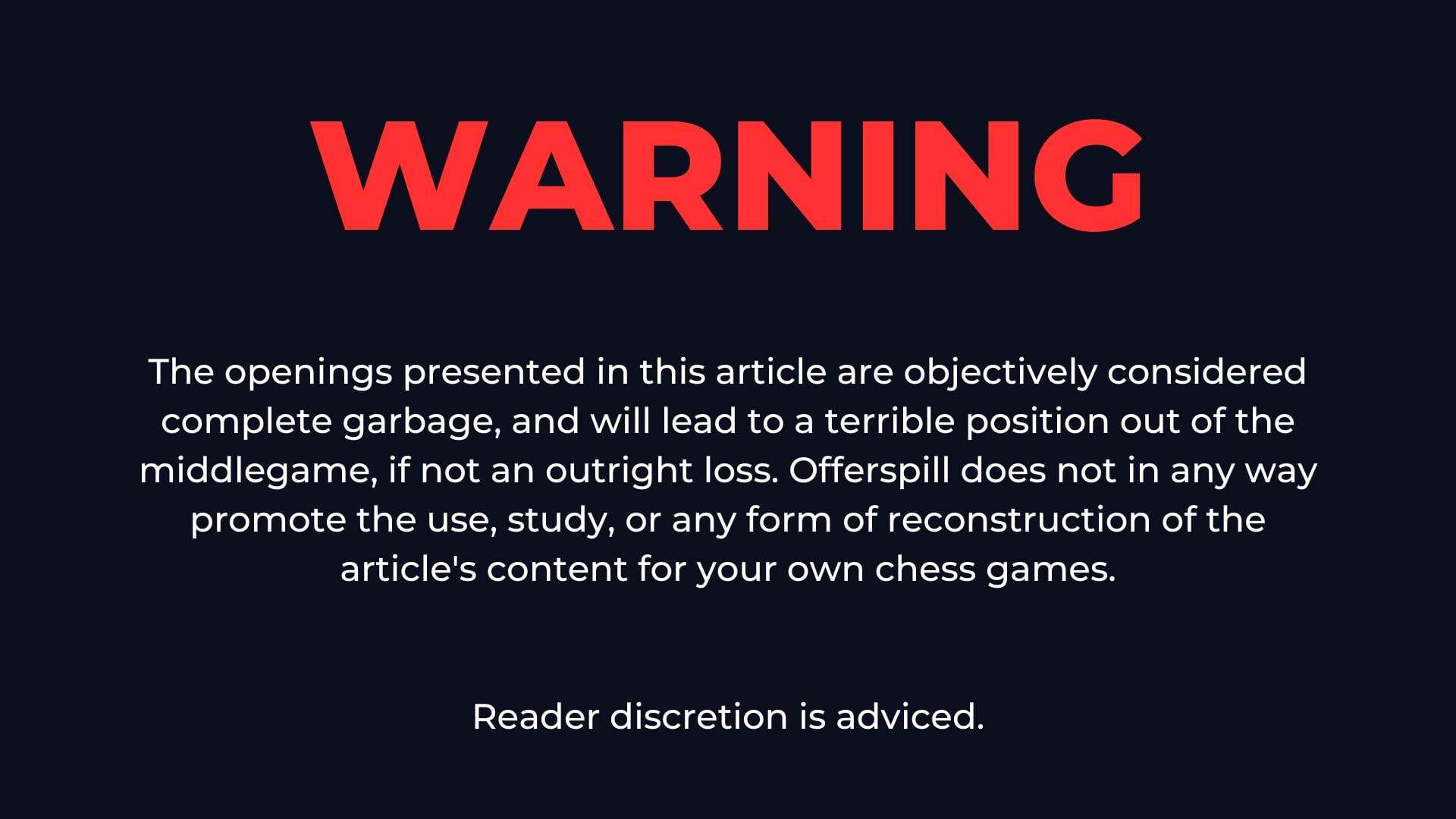
Most experienced chess players who have heard of the general rules that help you get through the opening phase: Take control over the center, get your king to safety, develop your pieces.
Less talked about the terrible openings. In fact, there are far more bad moves than good ones at any point in a chess game. The reputation of bad openings, however, hasn't stopped Magnus Carlsen from exploiting them in top-level online tournaments with good results (albeit in shorter time controls). In addition to giving oneself an extra challenge, there are plenty of players who value wins from these positions more than winning a regular, logical game. These openings quickly put psychological pressure on the opponent, who often responds too aggressively to punish the disrespectful behavior.
As a player totally devoid of shame, I naturally have tons of experience with these opening ideas from online experimentation. Through uncritical analysis and pseudoscience, I present to you the ultimate, exceptionally objective list of which creative openings definitely must be played, and which ones are better served in the dumpster.

These are the criteria for a good bad opening
- Universality: As any bad opening enjoyer knows, it's no fun to play in a way that requires your opponent to make specific moves. Therefore, part of the score will be based on how often you manage to play out your opening without the opponent making annoying moves to disrupt your setup.
- Tilt Factor: Our goal by playing bad openings is, of course, to tilt your opponent so bad that they start reconsidering their life choices. The angrier the opening makes the opponent, the higher the score.
- Meme Potential: One of the sub-goals of playing bad openings is to appear on the front page of r/anarchychess. Chess humor is thus an important criterion for this list.
- Playability: We should be in a bad position after the opening, but a bad opening must still give us a way to continue playing. High playability increases the chances of success.
Individual judgment is used in case of tied scores.
Enough chit-chat! Here are ten openings that are guaranteed to trigger the paragraph in FIDE's regulations about bringing chess into disrepute.
Number 10: The London System

The opening for those who like to watch paint dry, think spices make food too exciting, and believe memorizing the dictionary is S-tier entertainment. London players are allergic to adrenaline and have no qualms about inviting their unsuspecting opponents into their colorless world.
The London System is the only opening that breaks the scale for playability, considering the fact that you have no plans left after playing Ne5 for the 11,000th time. The system can be played against anything black cooks up, making it the perfect opening to ruin the joy of chess enthusiasts worldwide. The opening is especially well-suited for people who want to see the player base die out in the long run.
Number 9: The Pawn Storm

A classic for everyone who played chess in elementary school. This is the opening for those who aren’t entirely sure how all the pieces move, so they play it safe and move only the pawns.
It’s pretty bad to lose against someone who just randomly spews pawns over the board in the opening, mainly because it’s not a particularly good strategy. Unlike many other openings on this list, where you just waste moves, you make your king extra weak by removing his majesty's defenders from the get go. This makes it hard to get a proper game out of the position, and in some cases, you’ll even be checkmated within 10 moves. Even for a true despiser of sound theory, I think we can safely let this opening go.
Number 8: Accelerated AlphaZero

AlphaZero took the chess world by storm, teaching us the true value of advanced h-pawns. Players of the accelerated AlphaZero opening have taken this lesson a bit too literally, using their first opening moves to rush a pawn to h6 before anything else has happened.
The advantage of this opening is that black at some point will have to react to the idea, and it’s not entirely clear how he should respond. The downside is that almost anything black comes up with is a good response. Accelerated AlphaZero gets a low ranking on this list because of its’ semi-legitimate strategic point and, unlike other openings on this list, you don't risk being mated in a few moves. It also doesn’t feel too bad for the opponent to lose to a player who is clearly up to date on the latest in computer chess.
Number 7: The Grob

Many have probably experimented with the Grob at some point, as the opening doesn’t require much chess knowledge beyond “I move g-pawn in opening, I very smart.” The Grob is considered the worst opening move in chess, simply because it creates a weakness that white will struggle with for the rest of the game. In practice, however, it is difficult for a human to exploit the opening blunder, and much can go wrong for black if they go into the critical variations.
I probably wouldn’t bring out this opening in classical chess, but in shorter time controls against an unprepared opponent, it works just fine. The opening loses value in terms of meme potential and tilt factor, as it seemingly appears that the Grob user is actually making a serious attempt at an opening.
Number 6: The Cow Opening

A true innovation from chess Twitch, with the well-known streamer Anna Cramling pioneering the opening. "The Cow" is proof that hundreds of years of chess theory hasn’t put an end to opening innovation. It also gives new meaning to a classic meme:
The opening allows you to both retain castling rights and develop pieces, so the playability is slightly improved compared to the bottom of the list. Like the Grob, the cow loses value as the opponent might get confused and start to think you’re actually trying to play a proper opening. However, it regains some of those points due to its reputation among chessfluencers. If you (for whatever reason) want to embark on this opening adventure, the entrepreneur has made a detailed video on YouTube.
Number 5: The Bongcloud

A true internet classic with a legendary origin story. In the Bongcloud opening, white forgets that they’re not playing the “King of the Hill” variant on Lichess, and moves the king straight into battle.
The theoretical variations (if one can call it theory) involve moving the king right back where it started, making it a great way to handicap yourself by losing castling rights and tempo. A very frustrating opening to lose against, but often creates a situation where white can make a comeback. Bonus points for being the prior world champion's meme of choice.
Number 4: The LGBT Opening

The opening for those who believe chess pieces are sexist and want to take matters into their own hands. Many roads lead to rome with this opening, as the goal is to swap the positions of the king and queen.
The opening loses much universality if your opponent understands what you are up to and actively plays to stop the reordering of pieces. However, it gains back points on maximum tilt factor and very high meme potential, as losing to someone who plays by different victory conditions than you in the opening rarely feels great. The LGBT opening is a great way to make your opponent never want to play chess against you again.
Bonus example from when famous streamer xQc played against this opening many years ago, a game that I remember for no particular reason at all:
Number 3

A new innovation in the chess world from the drama surrounding player Viih_Sou, who defeated Daniel Naroditsky in a series of online games by giving up material in the opening. This very suspect opening has some real attacking plans, which honestly are not so easy to handle if you haven’t seen it before.
Another opening I would be reluctant to bring out in classical chess, as an opponent with time to think will see through the opening’s cheap tricks. Fun to play, but a bit too serious to really make the opponent see red.
Number 2: The Knight Retreat

The opening for people who think tempo in chess is overrated. The Knight Retreat is a sort of modern opening on speed, and aims to move the knight back and forth until the opponent puts pressure on the square you’re trying to jump to. The Knight Retreat poses the legitimate(??) question: “How can I have any weaknesses in the position when I haven’t actually moved any of my pieces?"
This opening allows the opponent to get so well-developed that you’ll have to hope for a blunder to keep the game going. Like other passive openings, your strategy will be to exploit bad piece placements. If your opponent makes a mistake and loses a piece, you suddenly find yourself in the driver’s seat and can steer towards a drawn-out endgame victory. Extra points for universality, as it can be played with both White and Black, but it is unfortunately quickly prevented if the opponent realizes it’s time to take control over the f3/f6 square.
Number 1: The Greek

At the top of the list, we find a world champion favorite. Magnus “DrGrekenstein” Carlsen has achieved multiple scalps with the somewhat sus but by no means trivial opening. The Greek has it all: It looks completely silly, is difficult to refute, can be played against any opening moves, and is guaranteed to tilt the opponent into oblivion. The opponent, usually getting ambitious from all your silly king moves, usually spends way too much time forcing the position open. This usually leads to them making bad decisions, often resulting in a surprisingly equal position. Just remember to play h4 if your opponent tries to play h5!
The greek is must-add in the repertoires of players of all levels, and a well deserving winner of the title “best worst opening”.
